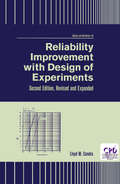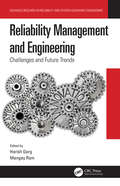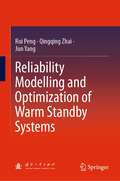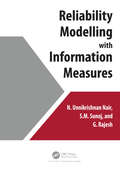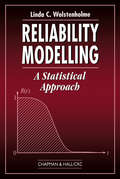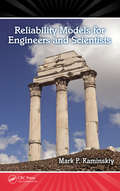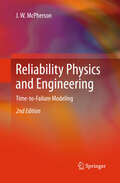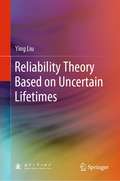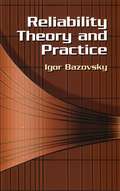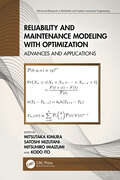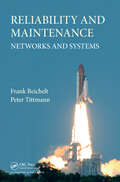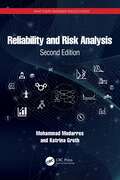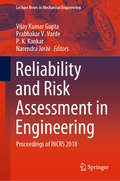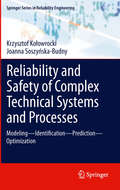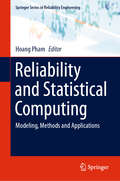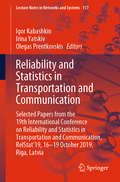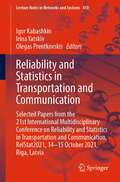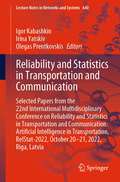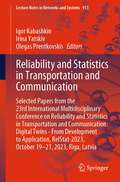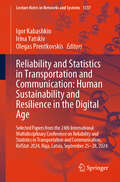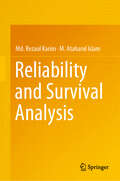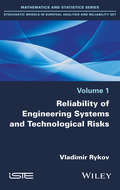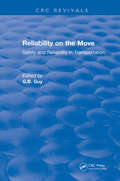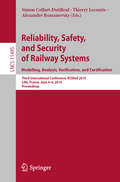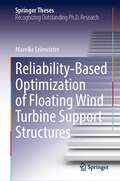- Table View
- List View
Reliability Improvement with Design of Experiment, Second Edition, (Quality and Reliability)
by Lloyd CondraA guide to implementing and operating a practical reliability program using carefully designed experiments to provide information quickly, efficiently and cost effectively. It emphasizes real world solutions to daily problems. The second edition contains a special expanded section demonstrating how to combine accelerated testing with design of experiments for immediate improvement.
Reliability Management and Engineering: Challenges and Future Trends (Advanced Research in Reliability and System Assurance Engineering)
by Mangey Ram Harish GargReliability technology plays an important role in the present era of industrial growth, optimal efficiency, and reducing hazards. This book provides insights into current advances and developments in reliability engineering, and the research presented is spread across all branches. It discusses interdisciplinary solutions to complex problems using different approaches to save money, time, and manpower. It presents methodologies of coping with uncertainty in reliability optimization through the usage of various techniques such as soft computing, fuzzy optimization, uncertainty, and maintenance scheduling. Case studies and real-world examples are presented along with applications that can be used in practice. This book will be useful to researchers, academicians, and practitioners working in the area of reliability and systems assurance engineering. Provides current advances and developments across different branches of engineering. Reviews and analyses case studies and real-world examples. Presents applications to be used in practice. Includes numerous examples to illustrate theoretical results.
Reliability Modelling and Optimization of Warm Standby Systems
by Jun Yang Rui Peng Qingqing ZhaiThis book introduces the reliability modelling and optimization of warm standby systems. Warm standby is an attractive redundancy technique, as it consumes less energy than hot standby and switches into the active state faster than cold standby. Since a warm standby component experiences different failure rates in the standby state and active state, the reliability evaluation is challenging and the existing works are only restricted to very special cases. By adapting the decision diagrams, this book proposes the methodology to evaluate the reliability of different types of warm standby systems and studies the reliability optimization. Compared with existing works, the proposed methods allow the system to have an arbitrary number of components and allow the failure time distribution of components to observe arbitrary distributions. From this book, the readers can not only learn how to evaluate and optimize the reliability of warm standby systems but also use the methods to study the reliability of other complex systems.
Reliability Modelling with Information Measures
by N. Unnikrishnan Nair G. Rajesh S.M. SunojThe book deals with the application of various measures of information like the entropy, divergence, inaccuracy, etc. in modelling lifetimes of devices or equipment in reliability analysis. This is an emerging area of study and research during the last two decades and is of potential interest in many fields. In this work the classical measures of uncertainty are sufficiently modified to meet the needs of lifetime data analysis. The book provides an exhaustive collection of materials in a single volume to make it a comprehensive source of reference. The first treatise on the subject. It brings together the work that have appeared in journals on different disciplines. It will serve as a text for graduate students and practioners of special studies in information theory, as well as statistics and as a reference book for researchers. The book contains illustrative examples, tables and figures for clarifying the concepts and methodologies, the book is self-contained. It helps students to access information relevant to careers in industry, engineering, applied statistics, etc.
Reliability Modelling: A Statistical Approach
by Linda C. WolstenholmeReliability is an essential concept in mathematics, computing, research, and all disciplines of engineering, and reliability as a characteristic is, in fact, a probability. Therefore, in this book, the author uses the statistical approach to reliability modelling along with the MINITAB software package to provide a comprehensive treatment of modelling, from the basics through advanced modelling techniques.The book begins by presenting a thorough grounding in the elements of modelling the lifetime of a single, non-repairable unit. Assuming no prior knowledge of the subject, the author includes a guide to all the fundamentals of probability theory, defines the various measures associated with reliability, then describes and discusses the more common lifetime models: the exponential, Weibull, normal, lognormal and gamma distributions. She concludes the groundwork by looking at ways of choosing and fitting the most appropriate model to a given data set, paying particular attention to two critical points: the effect of censored data and estimating lifetimes in the tail of the distribution.The focus then shifts to topics somewhat more difficult:the difference in the analysis of lifetimes for repairable versus non-repairable systems and whether repair truly ""renews"" the systemmethods for dealing with system with reliability characteristic specified for more than one component or subsystemthe effect of different types of maintenance strategiesthe analysis of life test dataThe final chapter provides snapshot introductions to a range of advanced models and presents two case studies that illustrate various ideas from throughout the book.
Reliability Models for Engineers and Scientists
by Mark P. KaminskiyA discussion of the basic reliability concepts and models, Reliability Models for Engineers and Scientists demystifies modern mathematical reliability models. Requiring very little mathematical background on the reader's part, this concise book introduces the models by focusing on their physical meaning and the supporting data; it then goes on to p
Reliability Physics and Engineering: Time-To-Failure Modeling, 2nd Edition
by J. W. Mcpherson"Reliability Physics and Engineering" provides critically important information for designing and building reliable cost-effective products. The textbook contains numerous example problems with solutions. Included at the end of each chapter are exercise problems and answers. "Reliability Physics and Engineering" is a useful resource for students, engineers, and materials scientists.<P><P> Includes eight new appendices plus three new chapters on screening, heat generation and dissipation, and sampling plans and confidence intervals
Reliability Theory Based on Uncertain Lifetimes
by Ying LiuThis book, to reflect the system’s diverse, relevant characteristics, uses three different mathematical tools, namely probability theory, fuzzy theory and random fuzzy theory, to model and analyze the reliability of each system. Reliability system engineering is an interdisciplinary area that chiefly focuses on the lifecycle characteristics of products and involves many fields of basic mathematics, technical science and management science. In recent years, there have been many books on reliability theory, but comparatively few on the reliability of mathematical models, or the reliability of mathematical models based on single probability theory or fuzzy theory. The findings presented here will not only enrich and expand traditional reliability theory, but also promote the development of related disciplines, lending the book considerable theoretical significance.
Reliability Theory and Practice
by Igor BazovskyWritten by a pioneer in the development of reliability methods, this text applies statistical mathematics to the analysis of electrical, mechanical, and other systems employed in airborne, missile, and ground equipment. Geared toward upper-level undergraduate and graduate students, it is also a valuable reference for professionals. 1961 edition.
Reliability and Maintenance Modeling with Optimization: Advances and Applications (Advanced Research in Reliability and System Assurance Engineering)
by Kodo Ito Mitsutaka Kimura Satoshi Mizutani Mitsuhiro ImaizumiReliability and maintenance modeling with optimization is the most fundamental and interdisciplinary research area that can be applied to every technical and management field. Reliability and Maintenance Modeling with Optimization: Advances and Applications aims at providing the most recent advances and achievements in reliability and maintenance. The book discusses replacement, repair, and inspection, offers estimation and statistical tests, covers accelerated life testing, explores warranty analysis manufacturing, and includes service reliability. The targeted readers are researchers interested in reliability and maintenance engineering. The book can serve as supplemental reading in professional seminars for engineers, designers, project managers, and graduate students.
Reliability and Maintenance: Networks and Systems
by Frank Beichelt Peter TittmannReliability and Maintenance: Networks and Systems gives an up-to-date presentation of system and network reliability analysis as well as maintenance planning with a focus on applicable models. Balancing theory and practice, it presents state-of-the-art research in key areas of reliability and maintenance theory and includes numerous examples and ex
Reliability and Risk Analysis: A Practical Guide, Third Edition (ISSN)
by Mohammad Modarres Katrina GrothCompletely updated for a new edition, this book introduces reliability and risks analysis, for both practicing engineers and engineering students at the undergraduate and graduate levels. Since reliability analysis is a multidisciplinary subject, this book draws together a wide range of topics and presents them in a way that applies to most engineering disciplines.What Every Engineer Should Know About Reliability and Risk Analysis, Second Edition, emphasizes an introduction and explanation of the practical methods used in reliability and risk studies, with a discussion of their uses and limitations. It offers basic and advanced methods in reliability analysis that are commonly used in daily practice and provides methods that address unique topics such as dependent failure analysis, importance analysis, and analysis of repairable systems. The book goes on to present a comprehensive overview of modern probabilistic life assessment methods such as Bayesian estimation, system reliability analysis, and human reliability. End-of-chapter problems and a solutions manual are available to support any course adoptions.This book is refined, simple, and focuses on fundamentals. The audience is the beginner with no background in reliability engineering and rudimentary knowledge of probability and statistics. It can be used by new practitioners, undergraduates, and first-year graduate students.
Reliability and Risk Assessment in Engineering: Proceedings of INCRS 2018 (Lecture Notes in Mechanical Engineering)
by Prabhakar V. Varde Vijay Kumar Gupta P. K. Kankar Narendra JoshiThis volume is a collection of articles on reliability and safety engineering presented during INCRS 2018. The articles cover a variety of topics such as big data analytics and their applications in reliability assessment and condition monitoring, health monitoring, management, diagnostics and prognostics of mechanical systems, design for reliability and optimization, and machine learning for industrial applications. A special aspect of this volume is the coverage of performance, failure and reliability issues in electrical distribution systems. This book will be a useful reference for graduate students, researchers and professionals working in the area of reliability assessment, condition monitoring and predictive maintenance.
Reliability and Safety of Complex Technical Systems and Processes
by Krzysztof Kołowrocki Joanna Soszyńska-BudnyReliability and Safety of Complex Technical Systems and Processes offers a comprehensive approach to the analysis, identification, evaluation, prediction and optimization of complex technical systems operation, reliability and safety. Its main emphasis is on multistate systems with ageing components, changes to their structure, and their components reliability and safety parameters during the operation processes. Reliability and Safety of Complex Technical Systems and Processes presents integrated models for the reliability, availability and safety of complex non-repairable and repairable multistate technical systems, with reference to their operation processes and their practical applications to real industrial systems. The authors consider variables in different operation states, reliability and safety structures, and the reliability and safety parameters of components, as well as suggesting a cost analysis for complex technical systems. Researchers and industry practitioners will find information on a wide range of complex technical systems in Reliability and Safety of Complex Technical Systems and Processes. It may prove an easy-to-use guide to reliability and safety evaluations of real complex technical systems, both during their operation and at the design stages.
Reliability and Statistical Computing: Modeling, Methods and Applications (Springer Series in Reliability Engineering)
by Hoang PhamThis book presents the latest developments in both qualitative and quantitative computational methods for reliability and statistics, as well as their applications. Consisting of contributions from active researchers and experienced practitioners in the field, it fills the gap between theory and practice and explores new research challenges in reliability and statistical computing. The book consists of 18 chapters. It covers (1) modeling in and methods for reliability computing, with chapters dedicated to predicted reliability modeling, optimal maintenance models, and mechanical reliability and safety analysis; (2) statistical computing methods, including machine learning techniques and deep learning approaches for sentiment analysis and recommendation systems; and (3) applications and case studies, such as modeling innovation paths of European firms, aircraft components, bus safety analysis, performance prediction in textile finishing processes, and movie recommendation systems. Given its scope, the book will appeal to postgraduates, researchers, professors, scientists, and practitioners in a range of fields, including reliability engineering and management, maintenance engineering, quality management, statistics, computer science and engineering, mechanical engineering, business analytics, and data science.
Reliability and Statistics in Transportation and Communication: Selected Papers from the 19th International Conference on Reliability and Statistics in Transportation and Communication, RelStat’19, 16-19 October 2019, Riga, Latvia (Lecture Notes in Networks and Systems #117)
by Igor Kabashkin Irina Yatskiv Olegas PrentkovskisThis book reports on cutting-edge theories and methods for analyzing complex systems, such as transportation and communication networks and discusses multi-disciplinary approaches to dependability problems encountered when dealing with complex systems in practice. The book presents the most noteworthy methods and results discussed at the International Conference on Reliability and Statistics in Transportation and Communication (RelStat), which took place in Riga, Latvia on October 16 – 19, 2019. It spans a broad spectrum of topics, from mathematical models and design methodologies, to software engineering, data security and financial issues, as well as practical problems in technical systems, such as transportation and telecommunications, and in engineering education.
Reliability and Statistics in Transportation and Communication: Selected Papers from the 21st International Multidisciplinary Conference on Reliability and Statistics in Transportation and Communication, RelStat2021, 14-15 October 2021, Riga, Latvia (Lecture Notes in Networks and Systems #410)
by Igor Kabashkin Irina Yatskiv Olegas PrentkovskisThis book reports on cutting-edge theories and methods for analyzing complex systems, such as transportation and communication networks and discusses multi-disciplinary approaches to dependability problems encountered when dealing with complex systems in practice. The book presents the most noteworthy methods and results discussed at the 21st International Multidisciplinary Conference on Reliability and Statistics in Transportation and Communication (RelStat), which took place remotely from Riga, Latvia, on October 14 – 15, 2021. It spans a broad spectrum of topics, from mathematical models and design methodologies, to software engineering, data security and financial issues, as well as practical problems in technical systems, such as transportation and telecommunications, and in engineering education.
Reliability and Statistics in Transportation and Communication: Selected Papers from the 22nd International Multidisciplinary Conference on Reliability and Statistics in Transportation and Communication: Artificial Intelligence in Transportation, RelStat-2022, October 20-21, 2022, Riga, Latvia (Lecture Notes in Networks and Systems #640)
by Igor Kabashkin Irina Yatskiv Olegas PrentkovskisThis book reports on cutting-edge theories and methods for analyzing complex systems, such as transportation and communication networks and discusses multi-disciplinary approaches to dependability problems encountered when dealing with complex systems in practice. The book presents the most relevant findings discussed at the 22nd International Multidisciplinary Conference on Reliability and Statistics in Transportation and Communication (RelStat), which took place on October 20 – 21, 2022, in Riga, Latvia, in hybrid mode. It spans a broad spectrum of advanced theories and methods, giving a special emphasis to the integration of artificial intelligent concepts into reliability approaches.
Reliability and Statistics in Transportation and Communication: Selected Papers from the 23rd International Multidisciplinary Conference on Reliability and Statistics in Transportation and Communication: Digital Twins - From Development to Application, RelStat-2023, October 19-21, 2023, Riga, Latvia (Lecture Notes in Networks and Systems #913)
by Igor Kabashkin Irina Yatskiv Olegas PrentkovskisThis book reports on cutting-edge theories and methods for analyzing complex systems, such as transportation and communication networks and discusses multi-disciplinary approaches to dependability problems encountered when dealing with complex systems in practice. The book presents the most relevant findings discussed at the 23rd International Multidisciplinary Conference on Reliability and Statistics in Transportation and Communication (RelStat 2023), which took place as a hybrid event on October 19 – 21, 2023, in/from Riga, Latvia. It spans a broad spectrum of advanced theories and methods, giving a special emphasis to the digitalization of transport systems, as well as smart, artificial intelligence, and digital twins applications.
Reliability and Statistics in Transportation and Communication: Selected Papers from the 24th International Multidisciplinary Conference on Reliability and Statistics in Transportation and Communication, RelStat-2024, Riga, Latvia, September 25-28, 2024 (Lecture Notes in Networks and Systems #1337)
by Igor Kabashkin Irina Yatskiv Olegas PrentkovskisThis book reports on cutting-edge theories and methods for analyzing complex systems, such as transportation and communication networks and discusses multi-disciplinary approaches to dependability problems encountered when dealing with complex systems in practice. It presents the most relevant findings discussed at the 24th International Multidisciplinary Conference on Reliability and Statistics in Transportation and Communication (RelStat 2024), which took place as a hybrid event on September 25-28, 2024, in/from Riga, Latvia. The chapters span a broad spectrum of advanced theories and methods, with a special emphasis on smart technologies and algorithms for enhancing sustainability and resilience of transport systems in various sectors.
Reliability and Survival Analysis
by Md. Rezaul Karim M. Ataharul IslamThis book presents and standardizes statistical models and methods that can be directly applied to both reliability and survival analysis. These two types of analysis are widely used in many fields, including engineering, management, medicine, actuarial science, the environmental sciences, and the life sciences. Though there are a number of books on reliability analysis and a handful on survival analysis, there are virtually no books on both topics and their overlapping concepts. Offering an essential textbook, this book will benefit students, researchers, and practitioners in reliability and survival analysis, reliability engineering, biostatistics, and the biomedical sciences.
Reliability of Engineering Systems and Technological Risk
by Vladimir RykovIn this book three main aspects are considered together: mathematical models for engineering systems reliability, the main concepts for technogeneous risk study, and insurance as methods for risks management. In the first part the author considers some special statistical problems concerning reliability data elaboration. The second part deals with the strong mathematical concept of risks and some problems for technogeneous risks insurance.
Reliability on the Move: Safety and reliability in transportation
by G.B. GuyThis book represents the porceedings of the 1989 Safety and Reliability Society Symposium held in Bath on the 11th and 12th of October on that topic.
Reliability, Safety, and Security of Railway Systems. Modelling, Analysis, Verification, and Certification: Third International Conference, RSSRail 2019, Lille, France, June 4–6, 2019, Proceedings (Lecture Notes in Computer Science #11495)
by Alexander Romanovsky Thierry Lecomte Simon Collart-DutilleulThis book constitutes the refereed proceedings of the Third International Conference on Reliability, Safety, and Security of Railway Systems, RSSRail 2019, held in Lille, France in June 2019. The 18 full papers presented in this book were carefully reviewed and selected from 38 submissions. They cover a range of topics including railways system and infrastructure advance modelling; scheduling and track planning; safety process and validation; modelling; formal verification; and security.
Reliability-Based Optimization of Floating Wind Turbine Support Structures (Springer Theses)
by Mareike LeimeisterThis book pursues the ambitious goal of combining floating wind turbine design optimization and reliability assessment, which has in fact not been done before. The topic is organized into a series of very ambitious objectives, which start with an initial state-of-the-art review, followed by the development of high-fidelity frameworks for a disruptive way to design next generation floating offshore wind turbine (FOWT) support structures. The development of a verified aero-hydro-servo-elastic coupled numerical model of dynamics for FOWTs and a holistic framework for automated simulation and optimization of FOWT systems, which is later used for the coupling of design optimization with reliability assessment of FOWT systems in a computationally and time-efficient manner, has been an aim of many groups internationally towards implementing a performance-based/goal-setting approach in the design of complex engineering systems. The outcomes of this work quantify the benefits of an optimal design with a lower mass while fulfilling design constraints. Illustrating that comprehensive design methods can be combined with reliability analysis and optimization algorithms towards an integrated reliability-based design optimization (RBDO) can benefit not only the offshore wind energy industry but also other applications such as, among others, civil infrastructure, aerospace, and automotive engineering.
